初中英语写作课教学案例 初三英语写作课ppt
- 格式:docx
- 大小:23.06 KB
- 文档页数:10
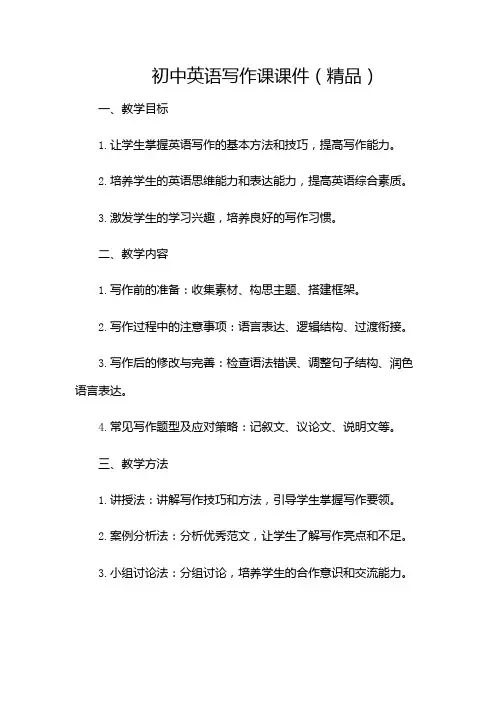
初中英语写作课课件(精品)一、教学目标1.让学生掌握英语写作的基本方法和技巧,提高写作能力。
2.培养学生的英语思维能力和表达能力,提高英语综合素质。
3.激发学生的学习兴趣,培养良好的写作习惯。
二、教学内容1.写作前的准备:收集素材、构思主题、搭建框架。
2.写作过程中的注意事项:语言表达、逻辑结构、过渡衔接。
3.写作后的修改与完善:检查语法错误、调整句子结构、润色语言表达。
4.常见写作题型及应对策略:记叙文、议论文、说明文等。
三、教学方法1.讲授法:讲解写作技巧和方法,引导学生掌握写作要领。
2.案例分析法:分析优秀范文,让学生了解写作亮点和不足。
3.小组讨论法:分组讨论,培养学生的合作意识和交流能力。
4.互动教学法:设置互动环节,激发学生的学习兴趣和积极性。
四、教学步骤1.导入:简要介绍英语写作的重要性,激发学生的学习兴趣。
2.讲解写作技巧:介绍写作前的准备、写作过程中的注意事项、写作后的修改与完善。
3.分析范文:选取不同类型的范文,引导学生分析其优点和不足。
4.小组讨论:分组讨论,让学生互相学习、互相借鉴。
5.互动环节:设置小游戏、情景模拟等,让学生在轻松愉快的氛围中提高写作能力。
6.课堂小结:总结本节课所学内容,布置课后作业。
五、课后作业1.按照课堂所学,完成一篇英语作文。
2.收集不同类型的英语范文,进行分析和点评。
3.阅读一篇英语文章,总结其主要内容和观点。
六、教学评价1.课后作业完成情况:检查学生的写作能力和学习态度。
2.课堂表现:观察学生在课堂上的参与程度和互动表现。
3.考试成绩:评估学生的英语写作水平。
4.家长反馈:了解学生在家学习英语写作的情况。
通过本课件的教学,相信同学们的英语写作能力会有所提高,为今后的学习和生活打下坚实基础。
需要重点关注的细节是“写作过程中的注意事项:语言表达、逻辑结构、过渡衔接”。
一、语言表达1.准确性:在写作过程中,学生应确保所使用的词汇和语法是准确的。
他们需要掌握足够的词汇量和正确的语法规则,以便能够准确地表达自己的意思。
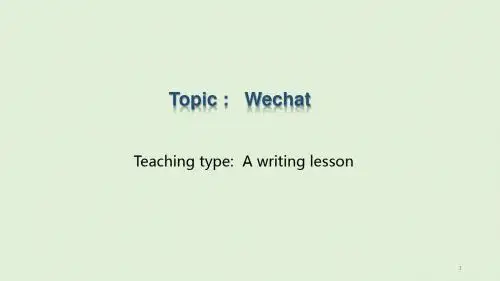





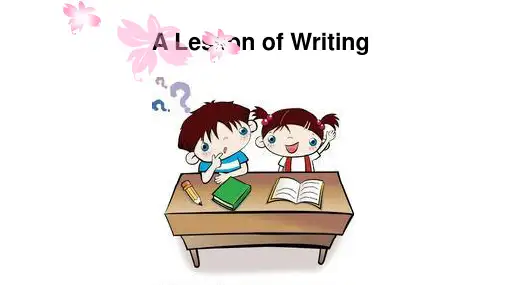
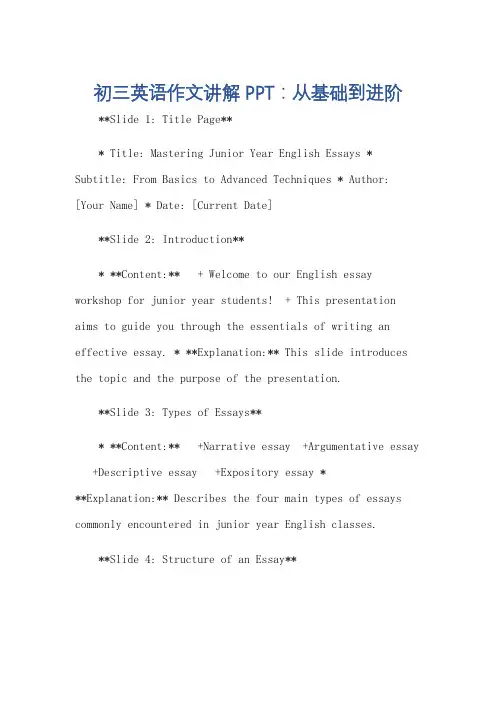
初三英语作文讲解PPT:从基础到进阶**Slide 1: Title Page*** Title: Mastering Junior Year English Essays * Subtitle: From Basics to Advanced Techniques * Author: [Your Name] * Date: [Current Date]**Slide 2: Introduction*** **Content:** + Welcome to our English essay workshop for junior year students! + This presentation aims to guide you through the essentials of writing an effective essay. * **Explanation:** This slide introduces the topic and the purpose of the presentation.**Slide 3: Types of Essays*** **Content:** +Narrative essay +Argumentative essay +Descriptive essay +Expository essay ***Explanation:** Describes the four main types of essays commonly encountered in junior year English classes.**Slide 4: Structure of an Essay*** **Content:** +Introduction +Body Paragraphs +Conclusion * **Explanation:** Outlines the basic structure of an essay and its key components.**Slide 5: Introduction: Hooking the Reader*** **Content:** +Use an interesting fact, quote, or anecdote. +Pose a question. +Start with a surprise. * **Explanation:** Discusses techniques to engage the reader in the introduction.**Slide 6: Body Paragraphs: Developing the Argument** * **Content:** +Topic sentence introducing the main idea. +Evidence and examples to support the topic sentence. +Transition words or phrases to connect ideas. * **Explanation:** Details the structure and content of body paragraphs.**Slide 7: Conclusion: Wrapping It Up*** **Content:** +Restate the main argument.+Summarize key points. +Leave a lasting impression. * **Explanation:** Explains how to effectively conclude an essay.**Slide 8: Language and Style*** **Content:** +Use active voice. +Vary sentence structure. +Employ figurative language. * **Explanation:** Tips on enhancing the language and style of your writing. **Slide 9: Common Mistakes to Avoid*** **Content:** +Grammatical errors. +Vague or unclear language. +Irrelevant or redundant information. * **Explanation:** Highlights common errors to be aware of when writing essays.**Slide 10: Practice Makes Perfect*** **Content:** +Regular practice improves writing skills. +Feedback from teachers and peers is essential. * **Explanation:** Encourages regular practice and the importance of feedback.**Slide 11: Resources and References*** **Content:** +Recommended books on essay writing.+Useful websites and online tools. * **Explanation:** Provides resources for further learning and practice.**Slide 12: Conclusion*** **Content:** +A brief recap of the presentation's main points. +Encouragement to apply the learnedtechniques in essay writing. * **Explanation:** Concludes the presentation with a summary and motivational message. **Slide 13: Q&A*** **Content:** +Open forum for questions and answers. * **Explanation:** Allows participants to ask questions and clarify doubts.---**初三英语作文讲解PPT:从基础到进阶****幻灯片1:标题页*** 标题:掌握初三英语作文 * 副标题:从基础到进阶技巧 * 作者:[你的名字] * 日期:[当前日期]**幻灯片2:介绍*** **内容:** + 欢迎来到初三英语作文讲解工作坊! + 本次演示旨在指导您掌握撰写有效作文的基本要点。

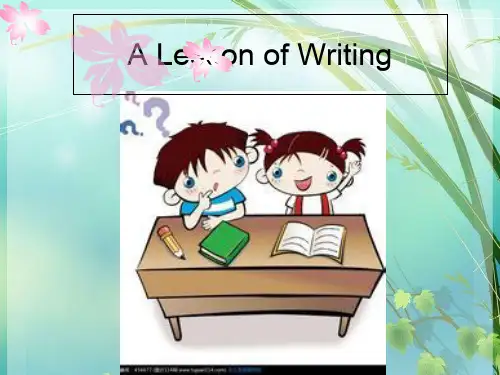
初中英语作文写作课优秀课件目录CATALOGUE •Course Introduction andObjectives•Fundamentals of Writing•Writing skills and methods•Common Theme WritingGuidelines•Appreciation and Analysis ofMasterpieces•Writing training andimprovement01CATALOGUECourse Introduction andObjectivesThe Importance of Middle School English Composition•Improving students' comprehensive English proficiency: Throughwriting training, students can better grasp language elements such asvocabulary, grammar, and sentence structures, and improve theiroverall English proficiency.•Developing students' cross-cultural communication skills: Englishwriting is one of the important means of cross-culturalcommunication. Through writing training, students can betterunderstand the culture and thinking patterns of English speakingcountries, and improve their cross-cultural communication abilities.•To lay a foundation for students' future learning and work: GoodEnglish writing ability is an important foundation for students' futurelearning and work, which can provide more opportunities for theirfurther education and career development.Course objectives and requirementsKnowledge objectiveTo master the basic knowledge and skills of English writing, including writing process, article structure,paragraph development, sentence structure changes, etc.Ability objectiveTo independently complete an English article with clear structure, rigorous logic, and fluent language, andpossess certain critical thinking and innovative abilities.Emotional goalTo cultivate students' interest and enthusiasm for English writing, improve their self-learningability and collaborative spirit.Course arrangement and scheduleCourse arrangementThis course is divided into 10 class hours, each lasting 45 minutes. The coursecontent includes explanation of basic writing knowledge, analysis of sampleessays, writing practice, and homework review.Class timeOnce a week, the specific time will be arranged according to the student'sschedule and actual situation.Teaching methodAdopting a combination of online and offline methods, providing coursewareand teaching videos online, and conducting face-to-face tutoring and Q&Aoffline.02CATALOGUE Fundamentals of WritingVocabulary accumulation and application•Positive vocabulary and negative vocabulary: Positive vocabulary refersto words that can directly express the author's intention in the article,while negative vocabulary refers to words that cannot directly expressthe intention but can increase the richness and readability of thearticle.•Semantic analysis and accurate word usage: In English, many wordshave similar meanings, but their usage scenarios and contexts aredifferent. Therefore, when writing, it is important to pay attention toword meaning analysis and choose the most accurate vocabulary toexpress one's thoughts.•Phrases and idioms: There are many fixed phrases and idioms inEnglish, and mastering these expressions can make the article moreauthentic and natural.Sentence Structure and Changes•Simple sentences, compound sentences, and compound sentences:Simple sentences only contain one subject and one predicate; Parallelsentences are composed of two or more simple sentences connectedby parallel conjunctions; A compound sentence contains a main clauseand one or more subordinate clauses.•Sentence pattern transformation and expansion: Through sentencepattern transformation, declarative sentences can be transformed intointerrogative sentences, exclamation sentences, etc., increasing thediversity and expressive power of the article. At the same time,sentence components can also be expanded, such as addingattributives, adverbials, etc., to make the sentence more specific andvivid.There are multiple tenses and voices in English, and using them correctly can make the article more accurate and fluent.The subject and predicate mustbe consistent in person andnumber, otherwise it will lead togrammar errors.Articles, pronouns, andprepositions play importantconnecting roles in English. Usingthese vocabulary correctly canmake the article more coherentand clear. Meanwhile, it is alsoimportant to avoid commonusage errors.Tense and voice Subject verbconsistency Articles, pronouns, and prepositionsGrammar rules and common errors03CATALOGUEWriting skills and methods03Conceptual contentBased on the theme, develop associations, and conceptualize the content and key points of the article.01Carefully review the questioncarefully read the question, understand its meaning, and clarify the writing requirements and limitations.02Determine the themeBased on the requirements of the title, determine the theme and central idea of the article.Topic review and conceptionArticle structure and layoutReasonably arrange paragraphs01Based on the content of the article, arrange paragraphsreasonably to make the article clear in hierarchy.Highlight topic sentences02Set topic sentences at the beginning or end of each paragraphto clarify the central idea of the paragraph.Pay attention to transitions03Use transitional words or phrases between paragraphs to makethe article coherent and natural.Language expression and rhetoric•Accurate wording: Choose appropriate vocabulary to express ideasand avoid using obscure or overly simple words.•Diverse sentence structures: Use different sentence structures toexpress ideas, such as simple sentences, compound sentences, etc., toenhance the expressive power of the article.•Using rhetoric: Use appropriate rhetorical devices such as metaphors,personification, and parallelism to make the article more vivid andvivid.•Pay attention to grammar and spelling: avoid grammar and spellingerrors, and maintain the accuracy and standardization of the article.04CATALOGUE Common Theme WritingGuidelinesNarrative Writing•Select a theme and plot: Choose an interesting story theme and planthe plot development, including the cause, process, and outcome.•Shaping character images: By describing the appearance, personality,behavior, and other aspects of characters, vivid character images arecreated.•Pay attention to detail description: Use vivid details to help readersbetter understand and feel the story context.•Reasonable arrangement of narrative sequence: Different narrativemethods such as sequential, reverse, or interlude can be used to makethe story more engaging.Choose a familiar objectof explanation, such as an object, event,phenomenon, etc., and provide a detailedintroduction and explanation.Clearlyexplain the objectCollect and explain information andinformation related to the target through channels such as books and theinternet.Collect relevant informationOrganize the content ofthe article in an organized manner according to differentexplanation orders suchas time order, spatial order, or logical order.Arrange explanation orderUsing different methodssuch as definition,classification, comparison, and examples to make the article moreaccessible and understandable.Usingexplanatory methodsExpository writingargumentative writing•Identify arguments and evidence: Choose a controversial topic, clarifyyour viewpoint and stance, and prepare supporting evidence tosupport the argument.•Reasonable arrangement of argumentation structure: Differentargumentation structures such as total score, listing themes, andfinding several parallel viewpoints to discuss the themes can be usedto make the article clear and organized.•Using argumentation methods: using different argumentationmethods such as factual argumentation, rational argumentation, andcomparative argumentation to enhance the persuasiveness of thearticle.•Pay attention to language use: Use accurate and concise language toexpress opinions, and avoid using words that are too absolute orvague.05CATALOGUE Appreciation and Analysis of MasterpiecesExhibition of excellent works by studentsWork 1"My Favorite Teacher"Work 2A Memorable DayWork 3"The Power of Friendship"Teacher comments and suggestions•Comment on work one: The article has a clear structure and fluentlanguage, showcasing the excellent qualities of the teacher throughspecific examples, expressing the author's love and gratitude towardsthe teacher. Suggest adding some detailed descriptions to make thecharacter image more vivid.•Commentary on Work 2: The article features novel material selectionand vivid narration, showcasing the author's love and optimisticattitude towards life by recounting interesting events that happenedduring the day. Suggest refining the language expression to enhancethe infectiousness of the article.•Comment on work three: The article has a profound meaning and clearviewpoint. By discussing the power of friendship, it expresses theauthor's appreciation and admiration for friendship. It is suggested toadd some specific examples during the argumentation process tomake the viewpoint more convincing.Interactive session: Student self-evaluation and peer evaluation•Self evaluation: I believe that I have a certain foundation in writing andcan express my thoughts fluently. But there is still room forimprovement in the selection of materials and ideas, and moreattention needs to be paid to observing and thinking about life.•Mutual evaluation one: I think his works have concise language andclear expression, but there are still shortcomings in detail descriptionand emotional expression. I hope he can pay more attention to detailsand emotional presentation in his writing.•Mutual evaluation two: I think her works have novel material selectionand unique perspectives, but in the process of argumentation, thereare some that are too simplistic and one-sided. I hope she can addsome specific examples and data support in the argument to make theviewpoint more convincing.06CATALOGUE Writing training and improvementClassroom timed writing exercisesStrictly set the timein a simulated exam environment, students are required to complete theiressays within the specified time.Diversity of topic selectionProvide different types of questions to expose students to and practice variousgenres and themes.On the spot reviewProvide real-time feedback on students' compositions, pointing out theirstrengths and weaknesses, and providing suggestions for improvement.Suggestions for independent training after classPersist in writingEncourage students to develop the habit of writingevery day, such as writing diaries, weekly notes, oressays.Expand readingRecommend English original works or articlessuitable for middle school students to read, broadentheir horizons, and accumulate materials.Reflection and revisionGuide students to reflect and revise their owncompositions, and improve their self correctionability.RegularassessmentConduct a formal writing assessment at regular intervals to assess students' learning outcomes.PersonalizedfeedbackProvide specific feedback andsuggestions for each student'sessay to help them identify theirshortcomings.Display andCommunicationSelect excellent compositions fordisplay and communication,allowing students to learn fromeach other and progress together.010203 Regular evaluation and feedbackTHANKS感谢观看。
初中英语写作课教学案例初三英语写作课ppt初中英语写作课教学案例How to keep healthy一、教学设计思路、指导依据说明:本话题是仁爱英语八年级上册第二单元的第二个话题,主要学习个人卫生和饮食健康等内容,也是中考中一个重要的话题。
本话题主要通过谈论如何养成良好习惯,保持健康,学习掌握重要句型和词汇;并通过阅读有关饮食健康的文章,引入更多的词汇,同时学会运用简单的阅读策略获取信息和学会保持良好的习惯。
最后以Project探究形式对所学内容进行运用,培养学生的综合语言运用能力。
即是能将所学的语言组织起来,写成语句连贯、表意准确的短文。
二、教学目标分析:1.学会描述良好的生活习惯。
2.根据所学的词或词组, 写出关于如何保持健康的重要性并给出好的建议的文章。
三、重点和难点分析:描述出保持健康的方法,以及自己的看法。
四、教学过程设计:Step 1. Lead in: 通过讨论下面的问题,引出本节课的大任务。
吸引学生,激发其学习兴趣,提高学生作为学习主体课堂参与意识。
列一个目录在黑板1. How often do you exercise ?2. How often do you eat vegetables?3. How often do you eat fruit ?4. How many hours do you sleep every night ?5. How often do you drink milk ?6. How often do you eat junk food ?7. How often do you drink coffee ?Step 2.Revision 让学生先以小组的形式复习section A 和section B的内容,使用大脑风暴法让学生brainstorm说出一些食物名称和healthy 有关的单词短语和句子,目的是激活学生头脑中和写作话题keep healthy 相关的东西来酝酿写作的思路,以便写作时能选择有意义的东西。
同时通过PPT出示一些good habits or bad habits及一些建议的短语:Taking a walk after meals. Taking a walk after meals. Drinking enough water every day. Washing hands before meals Eating too much meat. Going to bed late and getting up late.Throwing litter around.Going to school without breakfast Problems: unhealthy Advice 1. should eat a lot of vegetables 2. should eat a lot of fruits 3. can drink milk every day 4. don t drink coffee 5. shouldn t eat junk food 6.exercise every day 7.should have eight hours sleep 8.don t play computer games or watch TV too muchStep3. 展示作文题目,指导学生如何谋篇布局,规划文章结构,起草文章,组织语言。
请根据课文所给的关于饮食和运动的信息提示, 以 How to keep healthy 为题写一篇70个词左右的短文。
Step4指导学生写作。
1. 通过链接让学生了解如何写好作文,并分析文章的结构:采用总分总|的结构来写。
本篇习作重在how to, 通过阐述好的生活习惯对健康的重要性来提倡健康的生活方式。
2. 让学生了解中考作文评分标准。
Step5. 出示一篇例文,让学生了解文章结构,并动手起草写作文。
Step6. Share the writing.1.小组成员互评互改:教师简要传授修改策略,同桌互相阅读作品,并做必要的修改,并用红笔划出好词、好句。
草稿必须签上批改同学的名字后上交。
2.在班上朗读一篇优秀的作文和中等的作品并一一进行点评。
点评两篇学生习作,选自一位基础较好的同学和一位基础一般的同学的作文。
教师根据上述提供的写作标准,详细点评两篇习作的篇章结构和句法功能。
目的是使学生尽力领会教师对文章的点评,培养学生选词和用词的能力,指导学生多模仿好文章的优点。
Step7. Homework.把修改好的作文公整地抄作文本上。
五、教学反思:本课的设计使学生从学习中学会了如何谈论保持身体健康,提高了学生学习兴趣,增加了学生的知识面,提供了一定的语言实践,锻炼了学生运用语言的能力。
不足的是孩子们对写句子还是存在很大的问题,一些学生还是中式思维句式,逻辑思维也较混乱。
在以后的英语写作中,讨论部分应该加进去多些句子,这样能更好的拓展学生的思路。
还要教给学生如何去修改自己的作文。
另外在今后的教学中还要增加其他不同类型的写作训练,以提高学生的写作能力。
初中英语写作课教学案例一.教材分析Section B的第四部分为写作板块,主题围绕假期计划vacation dreams。
题目要求学生设想一个理想中的假期并写下打算做什么,什么时候去,打算呆多久等信息。
这部分左边配有一幅插图,右边为示例范文的节选,给出了句型和语法。
教材要求学生完成一篇描写假期安排的小作文。
[分析缺乏条理性]二.学情分析本节课面向初二学生,年龄处于13,14岁之间,学生学习热情高,自信心强。
经过初一的学习,学生已经具备较好的语言基础,有一定的词汇量和语法知识,能够进行简单的写作。
在上完本课Section A的内容后,能正确拼写本课有关的词汇并掌握了现在进行时表将来的时态。
面临的主要问题是部分学生一见到英语写作就产生恐慌心理,特别是当看到有些情境难以用英语表达出来时。
再次,学生容易轻视谋篇。
认为书面表达构思简单,只要没有语言、语法错误再加上几个漂亮的句子就能拿高分。
其次,一些学生不知道写作的主旨意图,以为写作就是要完成教师布置的任务。
很多学生基本功很差,学习比较懒散,不愿积累。
三.教学目标分析1.语言知识目标2. 语言技能目标能运用本课的词汇与句型写调查报告,介绍自己以及小组同学的度假安排;3.情感态度目标能在描述自己的计划和打算时,激起学生更加热爱祖国的美好河山。
4. 学习策略目标:1.在学习中集中注意力;积极思考;善于记要点;2.学会科学安排自己的假期活动,能和合作伙伴互相交流,充分交换信息。
3.能在小组活动中积极与他人合作,相互帮助,共同完成学习任务;4.在使用英语中,能意识到错误并进行适当的纠正;5. 文化意识目标了解英美国家的人们在工作之余是如何轻松度假的。
四.教学重点和难点学会科学安排自己的假期活动并能灵活运用于生活中。
提高写作能力。
五.教学过程设计自己先写一篇,看难点在哪,再设计教学任务。
初中英语写作课教学案例一、案例背景英语写作一直是得分最为薄弱的一个题型。
究其原因,一是学生写作练习的时间少,二是教师平时缺乏对学生进行系统的写作知识指导。
这样,形成了学生从最初不会写、盲目写到不愿写、惧怕写,直至最后拒绝写的恶性循环。
针对这一现象,我在教学过程进行了一次如何提高学生写作能力的课堂实踐。
教师旨在通过与学生谈论他们熟悉的话题 making friends ,搜索学生头脑中有关朋友的消息,通过阅读两则e-pal广告,获取e-pals的一些信息,指导如何写e-mail ,从而达到给e-pals 写信的目的。
二、案例过程1.Warm-up活动。
听英语歌 The more we get together, the happier well be 。
目的是活跃气氛,为引出今天的话题作准备。
2.Revision(1)使用大脑风暴法(brainstorm)让学生想出一些和friends 有关的单词短语和句子,目的是激活学生头脑中和写作话题make friends 相关的东西,如想法、概念、形象等,酝酿写作的思路,供拟稿阶段(drafting stage)选择有写的价值和意义的东西时参考。
(2)根据下列所给提示介绍你的朋友(四人一小组)。
1)Name and age.2)Where he / she comes from subject?3)What he is?4)What his / her friend?5)looks(外貌).6)personality(性格).7)His / Her dream.3.Pre-reading。
提问,How can you know your friends, if you havent seen each other for a long time? 联系朋友有很多方法,但是 One of the best ways issending e-mails to them. Do you know why?过渡到今天话题的材料,快速看完两则e-pal广告,找出答案。
4.While-reading。
读两则广告,了解Mary和Jack。
完成表格 Name Age Hobbies Looks Personality E-mail added Wish Where she5.Post-reading。
引导学生讨论:Do you like to make e-pals with Mary or Jack? Why? 当大部分学生都持肯定观点时进一步思索,What will you write in you e-mail to them? 为下面事实写作埋下伏笔,提供铺垫。
6.While-Writing。
教会学生正确使用e-mail格式,同时提供关于朋友和友谊的一些精彩句子,为学生写作提供素材。
7.Share the writing。
点评两篇学生习作,选择一位基础较好的学生和一位基础一般的学生的作文。
教师根据上述提供的写作标准,详细点评两篇习作的篇章结构和句法功能。
目的是使学生尽力领会教师对文章的点评,培养学生选词和用词的能力,指导学生多模仿好文章的优点。
三、案例反思写作是一个由浅入深、由易到难、由简到繁的训练过程。
因此,我们必须在平时就十分注重方法与技巧。
1.注意多种训练方法相结合。
①与任务(task)相结合。
②组织多样的小组活动。
2.平时注重解题技巧的养成。
1.准备工作。
①仔细审题,明确要求。
②紧扣要点,寻求思路。
草拟一个提纲,按时间、空间或逻辑顺序,确定开头,再围绕这一顺序,周密选词、选句,并拟好如何结尾(可适当发表自己的观点)。
(2)写作之中。
①开门见山,紧扣主题。